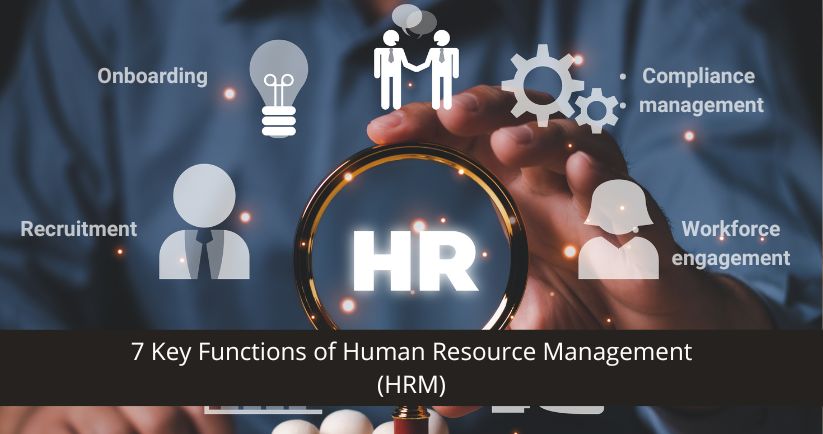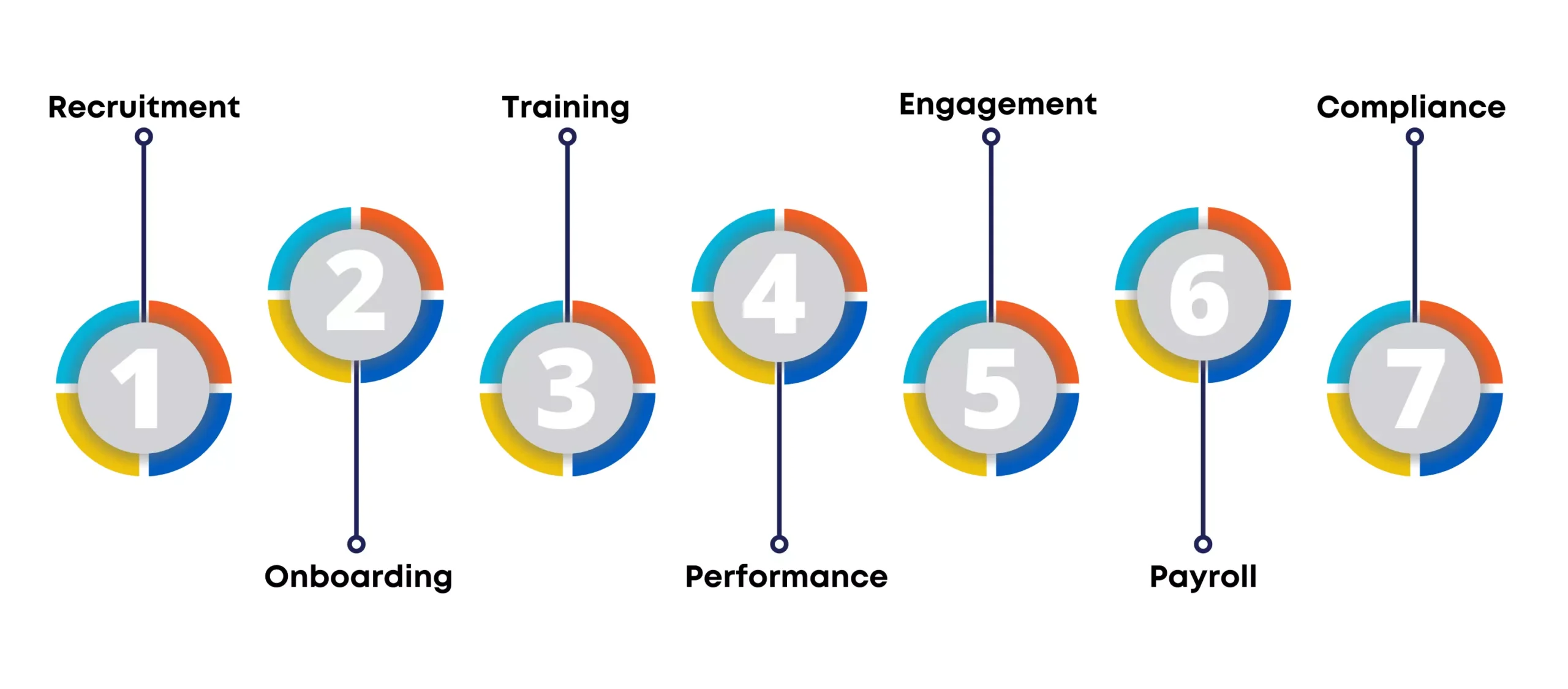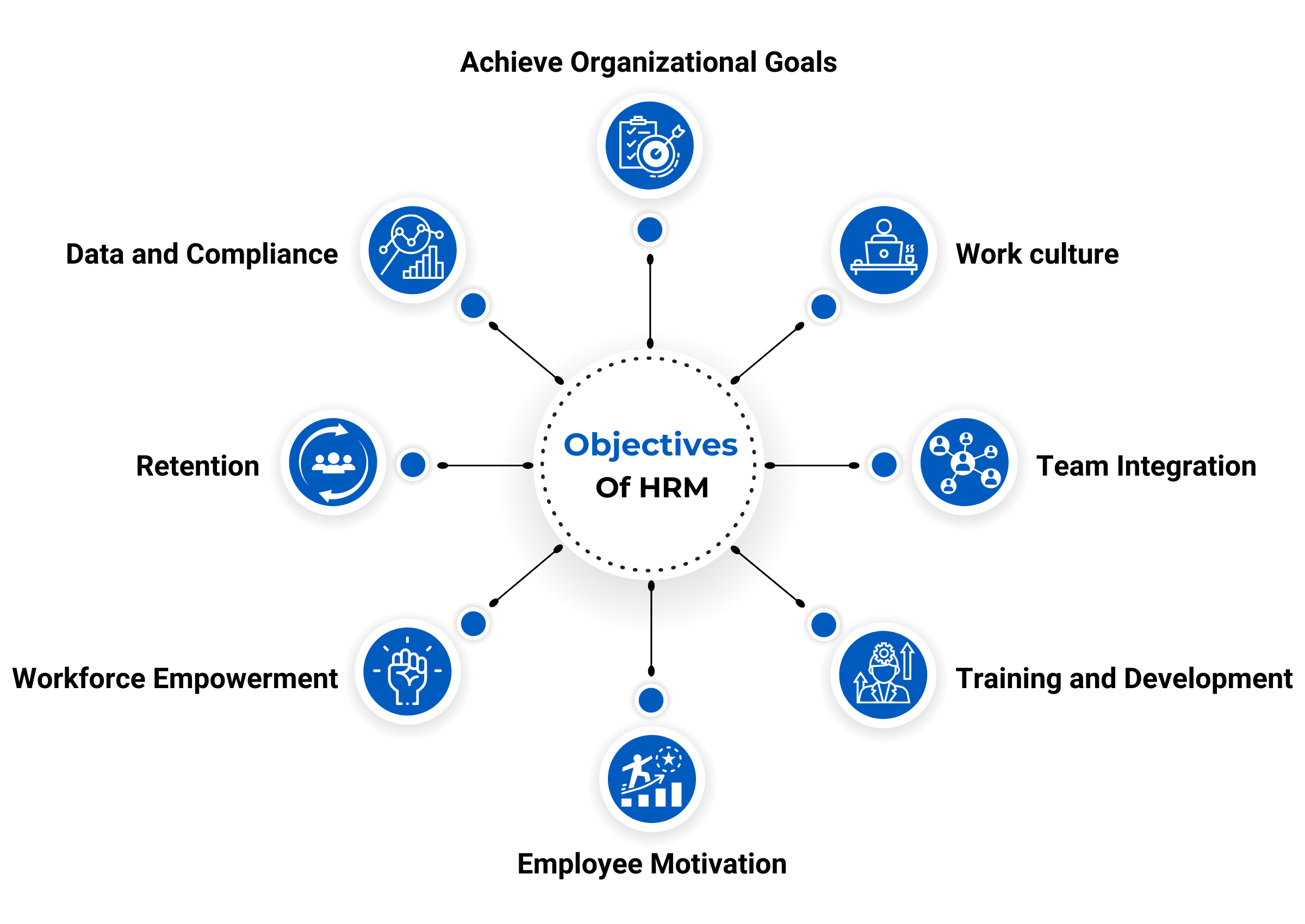What is Human Resource Management (HRM)?
HRM or Human resource management is the practice to manage employees and fulfill organizational requirements. Human resource management is an approach to meet one’s requirements and motivate them to perform at their best. Human resource management includes certain roles and responsibilities of HR.
What are the functions of Human Resource Management (HRM)?
The HRM definition itself hints at the major functions of human resources. The prime function of HRM is to fulfill staff needs and employee experience along with monthly payroll. The functions of human resource management may read from hiring interns to the full and final settlement of people leaving the organization.
This blog will read out some popular Human Resource Management(HRM) functions and actual benefits to a business. So, let’s dive into the intuitive functions of human resource management.
Listed below are the 7 key functions of Human Resource Management:
- Talent hiring
- Onboarding
- Training management
- Performance appraisal
- Workforce engagement
- Payroll management
- Compliance management
Let’s discuss each HRM function in detail:
1. Talent hiring
Recruitment is no kid’s game when it comes to filling 15 vacancies within a month or two. Captivating, screening, scheduling interviews, following up with rounds, etc. take a huge of your effort and time.
The role of HR manager here is not just to fill in the desks, instead talent acquisition is the need here. Talent hiring is one of the most important HR responsibilities. Before getting straight into the recruitment, functions of hrm involve proper plans and execution plan to not miss any candidate or round.
A dedicated solution like human resource management software can help you commit hiring process easily and effectively. Easy template generation and ATS (Applicant tracking system) make it very easy and less time-consuming to hire the best talent for the organization
2. Onboarding
Once you conclude with hiring people, it is one of the very important functions of the human resource department to orient them to the organization. This ensures that the new joiners feel comfortable and blend in quickly with the culture.
Effective onboarding as the HR solution does, ensures a smooth orientation process. Proper training management wherever necessary needs to be done. An employee must be well aware of their responsibilities and resources. Onboarding and training are two crucial functions of HRM as it decides the make and break of employee relations with management.
3. Training management
What are some major functions of human resource management? Training and development are definitely among them! As discussed earlier, improper training programs can be responsible for employees leaving the organization within 2 months of joining. No clear statements and work responsibilities can force them to quit.
Transparency of company goals and resources can help motivate employees to work at their best and deliver the needed. Educating effectively on company requirements and their contribution can help retain the employee. Company growth with clear communication is what helps the employees the most.
4. Performance appraisal
Performance appraisals are a key factor in determining compensation packages and benefits for employees, making it one of the best ways to recognize their hard work and dedication. Reviewing and rewarding through compensation and benefits is a good practice and one of the important functions of HR. Regular recognition of hard work and good intuition towards business growth, aligned with competitive compensation and benefits, promotes growth in performance and improved productivity. An automated platform like human resource management software (HRMS) helps in accurate feedback and reviews to an employee based on his/her performance, which is crucial for designing and implementing fair and equitable compensation strategies.
The degree feedback process for performance management becomes easy with the software with an easy selection of reviewing groups like managers, colleagues, clients, etc. The process needs to be fair and transparent, ensuring that compensation and benefits reflect the individual and team contributions effectively.
5. Workforce engagement
Managing employees is every HR’s big game. Keeping them acknowledged and satisfied with activities and HR strategies is important for the human resource department. After all, employees are the pillar of any organization. Managing the right way can win you improved productivity and less employee turnover.
The workforce engagement and management solutions help foster better employee relations at the base. It also promotes a better work environment. One most popular and effective employee engagement tips could be employee empowerment.
A useful tool like ESS portal helps your employees serve themselves and prevent HR intervention all the time. No more need to knock on HR’s door to ask mundane queries. The self-service portal lets them easily download salary slips through mobile phones. Also, leave requests are made easy with the portal.
6. Payroll management
Here comes the toughest job in HR. Keeping up with compliances and tax amendment is not so easy. Performing payroll barehanded without software assistance could be an open invitation to penalties and huge errors.
With the ever-changing amendments and laws, committing to payroll becomes difficult for the HR department. Providing salaries keeping abide by tax rules and proper deductions like PTax, PF, LOP, etc. makes it very critical and error-prone to commit single-handily.
Software assistance like payroll software makes it a piece of cake for the human resource and payroll department. Keep the errors & IRS penalties at bay with a dedicated payroll solution. Keeping up with the right calculations is important for the right HR management.
7. Compliance management
Be it statutory compliance or keeping up with employment laws, compliance management & keeping the organisation away from mistakes is your sole responsibility. An automated payroll system helps you stay away from unwanted situations.
Managing compliance is one of the most underestimated functions of human resource management. But it isn’t. Even a tiny miscalculation can owe you huge penalties & regret would be the only reaction.
Taking precautions and relying on online payroll software can help you. The HR solution with an integrated payroll module lets you sit back and enjoy an error-free & timely payroll for employees. Informative reports and slips leave no second doubt in HR management.
Below are the managerial functions of HRM:
- Planning
- Organizing
- Directing
- Controlling
➔ Planning
Strategic planning and implementing it in a proper way must be the best procedures to reach the goals. With a robust plan, you can get things done within a timeline. This planning must include determining the personnel programs, anticipating the hiring needs of the organization, and planning job requirements, descriptions, etc of the human resource department.
➔ Organizing
After strategies a plan, it is important to organize the plan properly. The task should be allocated to every employee with respect to their skill and expertise. It is the most important part of Human Resource Management as proper skills and activities are integrated towards company productivity.
Steps to organize the workplace structure includes:
- Research and analyze which individual is suitable for which positions
- Assign different activities to different individuals
- Coordinating activities of different employees
➔ Directing
After the phases like research, analysis, and organizing, one of the crucial phases is directing the workers. In this phase, you can encourage the employee to work willingly and efficiently for their own success and involve them in the organizational responsibilities.
Simply, the direction phase of HRM ensures entire guiding and motivates employees in achieving the personnel programs
➔ Controlling
Controlling is all about regulating all the previous activities according to further changes. In this phase, the managers observe the employees’ activities and compare the result to set the standard. The process may often create some controversies but it helps companies to evaluate and control the performance. Strategic control leads to company productivity. It also includes statistics, appraisals, audits, etc.
How to manage HR for small businesses and start-ups?
For SME owners and start-up owners – Commitment to human resource management may not be so easy when it comes to a small workforce and shortage of resources. Thinking of processing payroll may sink your organization in losses and inefficiencies.
Instead, economical monthly subscriptions can help you survive better. Be it an SMB or MNC, payroll can be equally challenging for both. Right measures can help!
Also Read: International HR Day 2024
Objectives of HRM
The organizational objectives of human resource management include:
➔ Achieve organizational goals
One of the significant objectives of HR management is to achieve organizational goals. The HRM organizational objectives include workforce handling, staffing, training and development, payroll management and employee settlement. For successful HR management, the HR manager requires efficient planning and execution. With resource management and proper execution, HR management is no difficult task.
➔ Work culture
Work culture and employee relations play a major role in defining objectives for human resource management. Automated HR activities like cloud payroll, timesheet software, data manager, etc. make up a good HR management strategy for the developed work environment.
Employee empowerment and transparency can help you achieve employee trust and better human resource management.
➔ Team integration
Team coordination and work integration amidst teams are some prime objectives of HR management. The HR professional must ensure smooth communication between departments. They must ensure resources are available to employees for achieving targets.
Successful team integration helps in achieving streamlined operations and bringing data under one platform.
➔ Training and Development
Effective employment and productivity of the workforce are highly dependent upon the training practices provided by HR and training officers. Providing opportunities to employees is one great step to ensure resource management.
There might be difficulties such as planning, scheduling, providing better training, and evaluation of each on-boards. To lessen the pain, solutions like training management system can help you create training templates, set schedules, reminders, etc. Automated training management makes your workforce the best fit for their roles.
➔ Employee motivation
Employee motivation is an important objective to achieve for HR managers. To keep employees motivated and on the right path, they need to be attended to and kept engaged throughout.
Empower them. Let them contribute to the organization and make them involved in plans. Involve them in weekly meets and decisions. Also, do not forget to recognize their efforts and achievements. Employee performance management can be the best way to motivate employees and keep them focused.
➔ Workforce empowerment
Employee self-service portal (ESS) allows employees to apply for approvals and track them through their mobile phones.
Be it a leave request, generating pay slips, checking PF account, on-duty request, upcoming holidays, manager details, or anything, HR intervention is eliminated. Workforce empowerment leads to employee retention.
➔ Retention
As discussed earlier, employee retention and effective resource management is the prime objective of the HR department. Offering competitive compensation packages and benefits is essential for retaining top talent and reducing turnover. If strategies are planned well and executed, employee trust is no milestone.
Employee hiring, onboarding, and training the employees are some prime functions of HR. On the other hand, keeping the employees retained is another challenge. Well, strategies like empowerment, training, motivation, etc. make employees stay.
➔ Data and Compliance
HR compliance has been always in best concern of HR managers. Defining compliances and laws will ensure the right employment and keep penalties away.
Data management and payroll management are areas where a human resource professional can contribute. IRS guidelines are very important to follow to adhere to the right employment practice. Whereas, cloud HRMS solutions can help you keep arrears and fines at bay with automated calculations.
What are the main functions of an HR manager?
The functions of an HR manager hold great significance to organizational growth and revenue. Let us quickly find out the main functions of an HR manager at an enterprise. Listed below are some:
- Job ad publishing
- Recruitment
- Resource management
- Managerial relations
- Employee relations
➔ Job ad design
Designing job descriptions and job ad on your portal is one of the foremost roles of your HR manager. Job design involves the process of describing duties, responsibilities, and compensation for the job. To hire the right employee, you need first to understand the candidate’s expectations, profile requirements, etc. This will help you determine the kind of candidate you want for the job.
Job designing involves describing the job requirements such as skills, qualifications, and work experience. Their daily duty and deliverables must be identified and described in detail, as this will decide the recruitment strategy.
➔ Recruitment
Recruitment is one of the most basic and equally important functions of the HR manager. HRM aims to select and retain qualified and performing employees to achieve their goals and objectives. All this starts with hiring the right employee from hundreds of applicants.
Human resource management also helps in sourcing and identifying ideal candidates for interview and selection. The applicants are then subjected to a designed screening process to filter out the most suitable candidates from the pool of interested applicants. The screened-in candidates are then taken through different interview rounds to test and analyze their skills, knowledge, and work experience required for the job position.
Once the main functions of HRM in staffing are achieved, and the candidate gets selected after their designed interviews, they are then provided with the job offer and ready to join. This process is important because these selected employees will, after all, help the company realize its goals and objectives.
➔ Resource management
Resource management at HR includes employee management and HR component handling. Components like service portals, desktops, connectivity, communication, mailer system, etc., which also make work easy and feasible need to be considered well by HR. This will ensure the smooth functioning of employees at work.
Also, you need to see to it that no performing employees feel unrecognised. Employee motivation and performance management are the keys to effective employee handling. Employee benefits and compensation are crucial factors in human/labour management.
➔ Managerial relations
There are two types of relations at an organization that the HR manager needs to consider and they include; managerial relations and labor relations.
Here, labor relations are mainly about the relationship between the workforce and the company and managerial relations deal with the relationship between the various processes in an organization.
Managerial relations determine the amount of work to be done in a given day and how to mobilize the workforce to accomplish the objective. It is about giving the appropriate project to the right group of employees to ensure the efficient completion of the project. Managerial relations also entails managing the work schedules of employees to ensure growth and improved productivity. It is mandatory to handle organizational relations effectively to maintain the efficiency and productivity of the company.
➔ Employee relations
As discussed earlier, relations are essential to maintain good work culture and relationships between employees at the workplace. At the workplace, many employees work hand-in-hand towards the same objective. Not a hidden truth – every employee has their own characteristics. Therefore, it is essential to handle such employees and relations proactively.
Toxic culture and reduced work productivity are the results of unattended employee relationship management. Therefore, it is necessary for the HRM to provide proper rules, regulations, and policies about labour relations. This way employees gain a proper framework to work and deliver. Every employee will thereby be aware of the policies, which will create a satisfactory work environment and ethics at work.
Conclusion
Human resource management can be easier and daunting depending on the tools you rely upon. As discussed in the article, human intervention in all the functions of human resource management include can be critical at times. With technological advancements i.e. HR technology, there are a lot many solutions available like HRMS software.
Each function includes some set of policies and strategies in order to be effective at efforts. Let not your effort go in vain. Get assistance with the right HR solution and excel in the area of human resource management.
Pocket HRMS is one such new-age HR software with integrated modules supporting each function of human resource management. To learn more, contact us here – sales@pockethrms.com.










